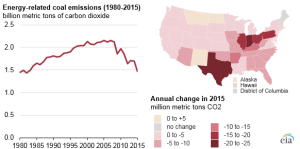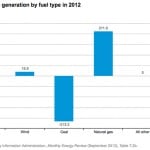A U.S. Energy Information Administration (EIA) analysis of carbon dioxide (CO2) emissions in 2015 from U.S. coal consumption shows 43 states recorded lower emissions year-over-year, with just four states showing increased levels, while three states and the District of Columbia had little to no emissions. On the whole, the EIA report released in mid-November comparing 2015 to 2014 showed a record year-over-year emissions drop of 231 million metric tons from coal consumption, with most of the decline attributed to reduced electricity production from coal-fired power plants.
EIA said more than 60% of the decrease came from 10 states, with the largest drops in Texas—where about 98% of coal consumption is for power generation—Indiana, Ohio, Illinois, and Pennsylvania (Figure 1). EIA used its latest available state-level carbon dioxide emissions data to compile its report. EIA noted that about 90% of U.S. coal consumption is from the electric power sector; the rest is mostly used by industry.
Interestingly, a report from Carnegie Mellon University supported by Mitsubishi Hitachi Power Systems (MHPS) released earlier this year showed that CO2 emissions from U.S. power plants were higher year-over-year for the first quarter of 2017 compared to the first three months of 2016. The report said the increase came because coal-fired generation made up a larger portion of the power mix, as higher natural gas prices led to less natural gas generation.
EIA economist Owen Comstock in the agency’s analysis of 2015 emissions said: “Most of the decline in 2015 U.S. coal consumption occurred in the electric power sector, where reduced coal-fired electricity generation was largely offset by higher natural gas-fired electricity generation.”
Comstock said some of the decrease could be attributed to the closure of coal plants that needed to meet an April 2015 deadline to comply with the EPA’s Mercury and Air Toxics Standard (MATS) rule.
The only states with increased emissions from coal consumption were Alaska, Montana, North Dakota, and New Mexico. Three states—Vermont, New Hampshire, and Maine—along with the District of Columbia do not burn coal, or use so little that emissions levels were mostly non-existent.
Comstock in the analysis noted that CO2 emissions from natural gas use “across all sectors increased 43 million metric tons,” mostly due to increased natural gas-fired power generation.
The trend toward reduced use of coal for power generation and increased use of natural gas and renewables continues as more U.S. coal plants are retired, including in Texas, where the closures of three large coal-fired facilities were recently announced, and where the generation capacity for wind power now outpaces coal. Closures of coal plants also were recently announced in Kentucky and Montana.
—Darrell Proctor is a POWER associate editor (@DarrellProctor1, @POWERmagazine).










